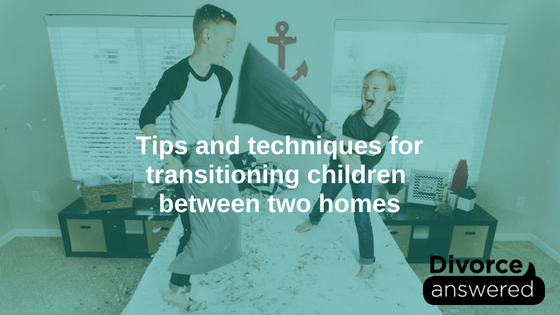Minimising anxiety and helping children transition between two homes

Sending children from one home to another and transitioning between parents can be difficult at times for the parents as it is for the children. As such, we have to appreciate that every person parents their child differently – no two people will be exactly the same. Also, try as you might, routines will be a little or vastly different in each home. Many primary (or live-with) parents remark that for as long as the child was with their spend-time-with-parent, it can take an equal amount of time to get the child back into rhythm with the primary parent.
When your child is with you, the focus shouldn’t be about being the ‘Disneyland’ parent, spending the most amount of money or buying the most amount of take-away or sugary foods. One day, your child will ‘see through’ the bought love and may ultimately use it to your disadvantage.
“What you do today to help your child feel more relaxed and comfortable when they are in your home and with you helps you to both to enjoy your time together more. When you are happier together it creates an ideal environment to connect with each other,” shares Rachael Scharrer, divorce and relationship expert, coach and founder of DivorceAnswered.com.au. Rachael shares tips that you can immediately implement and use to help reduce your child’s anxiety and help them to transition between the two homes:
- Choose your attitude. We can choose how we react and respond. Choose patience - Your child will need time to settle into the new surroundings. Your patience, rather than frustration, will help towards speeding up the adjustment. Be positive - Be positive about the time your child spends with their other parent. It is also help
- Be prepared to be flexible as your child matures. As your children get older, their needs will change, especially as they become teenagers. Try to negotiate with them while understanding the child’s needs, priorities and perspective. For instance, I met a father who was the spends-time-with-parent. He wanted time with his teenage son but the son wanted a social life. They agreed that the son could spend the father’s allocated weekends wherever he wanted (with either of the parents) and see his friends as long as he promised to give 4 hours to the father on the Sunday.
- Agree to put the children’s best interests and needs first. Sometimes children need reassurance from their other parent. If they are uncomfortable, allow them to call the other parent whenever they want.
- Love your child through the challenges. Your child doesn’t need a best friend, they need a parent. They need lots of love and understanding. Sometimes your child will need the freedom to express their grief, frustrations and anger. They should be allowed to “cry it out”
- Plan your communication with your child’s other parent. Both parents might like to come to an agreement about how to communicate the particulars of their time with their child, any concerns, issues or medical treatment by using a communication book or by sending a summary email. This helps each parent feel informed and abreast of any concerns and it promotes an appearance of a ‘united front’ or ‘being on the same page’ for the child.
- Having a constant for your child. Have a toy or item that moves between home or a picture of the other parent in your home. It may be a cuddly toy, a photograph or (for some families) a family pet moves with the child (see “Fred Stays With Me” book review). This is especially prevalent when the child needs a therapy dog or they have anxiety moving between homes.
- Reset on neutral territory. Some children can feel fractious and unsettled when starting their time with one parent. Try to go to neutral territory (like the supermarket) to give them some time to re-adjust to being with the ‘new’ parent and at the same time they can pick some food to have at home.
To be a parent is a verb, not a noun. It isn’t just a title you receive when you have a child. It is about the act of being involved, active and connected. How you choose to care for your child when they are with you can make the difference between enjoying your time together or not.
Have you got any other suggestions for moving children between homes – please email your suggestion or what works for you to contact@divorceanswered.com.au
